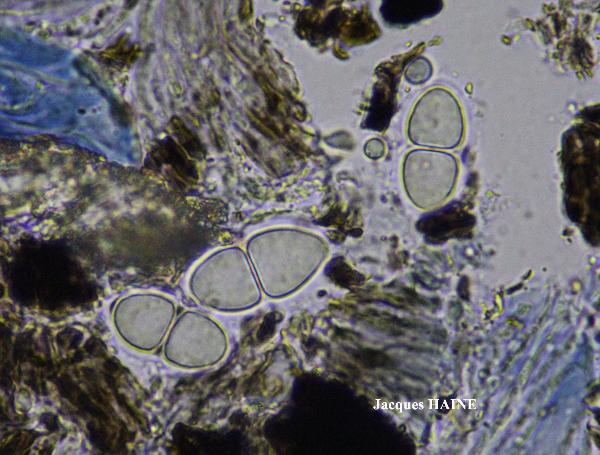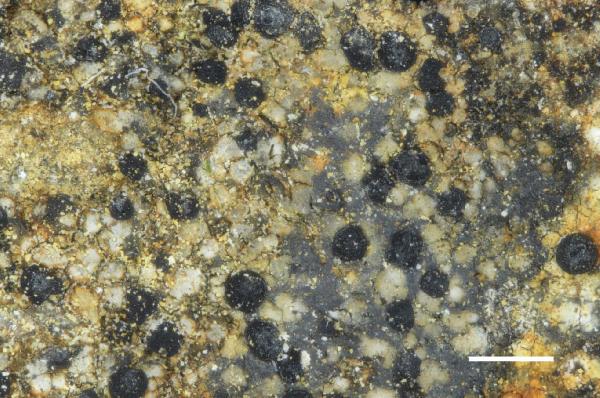Poeltinula infernula (Nyl.) E.J. Möller, Timdal, Haugan & Bendiksby
Fungal Syst. Evol., 16: 224, 2025. Basionym: Lecidea infernula Nyl. - Flora, 68, 24: 440, 1885.
Synonyms: Rhizocarpon infernulum f. infernulum (Nyl.) Lynge; Rhizocarpon massalongii f. infernulum (Nyl.) Zahlbr.
Distribution:
Description: Thallus crustose, episubstratic, pale grey to grey-brown, rimose to areolate, the areoles flat, 0.3-0.4 mm wide, forming small, usually less than 2 cm wide patches. Medulla white, I-. Apothecia, lecideine, black, developing among the areoles, 0.3-0.4(-0.5) mm across, with a flat to slightly convex disc and a more or less distinct, finally sometimes excluded proper margin. Proper exciple dark throughout, of radiating, dark brown hyphae; epithecium green to blue-black, K-, N+ red; hymenium colourless, I+ blue; paraphysoids branched and anastomosing, coherent in water but easily made free in K, 2.5-3 µm thick at mid-level, the apical cells abruptly swollen, to 3 µm wide, with a sharply delimited dark cap; hypothecium dark brown. Asci 8-spored, clavate, fissitunicate, with a well-developed tholus, lacking an ocular chamber, Rhizocarpon-type. Ascospores 1-septate, hyaline, 15-18 x 7-8.5 µm, halonate. Photobiont chlorococcoid. Spot tests: medulla K+ yellow or K-, C-, KC-, P+ orange or P-. Chemistry: medulla with stictic acid, or without lichen substances.Note: a silicicolous species of rather exposed sites, most frequent in Western Europe, with a single record from the Western Alps (Switzerland). To be looked for in the Italian Alps.
Growth form: Crustose
Substrata: rocks
Photobiont: green algae other than Trentepohlia
Reproductive strategy: mainly sexual
Most common in areas with a humid-warm climate (e.g. most of Tyrrenian Italy)

Predictive model
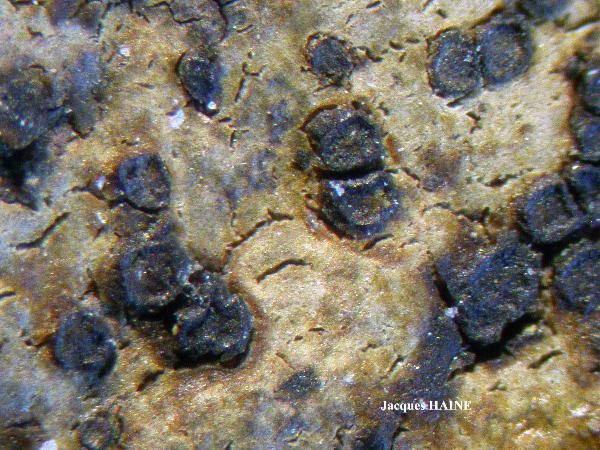
Jacques Haine - Source: http://www.lichensmaritimes.org/index.php?task=fiche&lichen=1157&lang=en
Belgium, Monthermé
f. sylvaticum Fryday
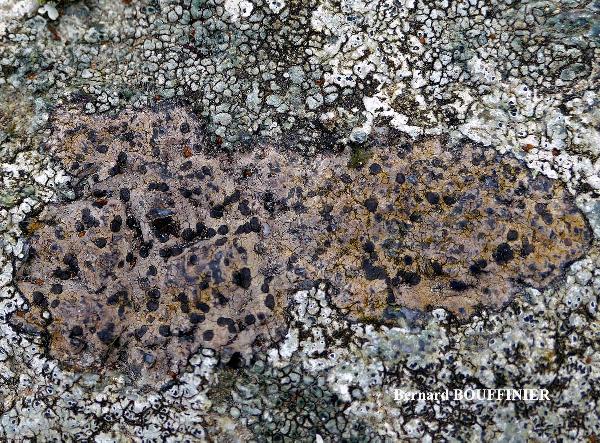
Bernard Bouffinier - Source: http://www.lichensmaritimes.org/index.php?task=fiche&lichen=1157&lang=en
France, Pont Releq
f. sylvaticum Fryday
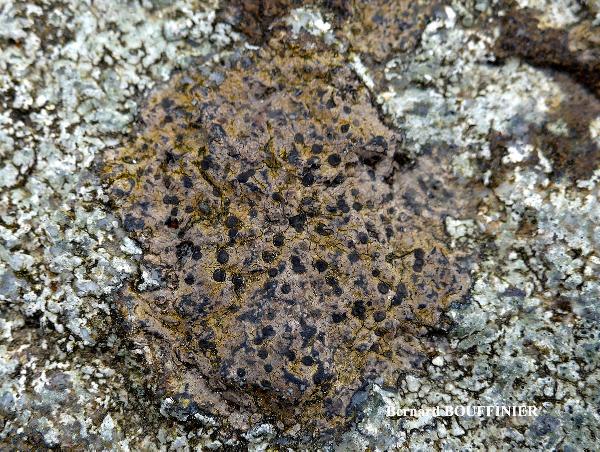
Bernard Bouffinier - Source: http://www.lichensmaritimes.org/index.php?task=fiche&lichen=1157&lang=en
France, Pont Releq
f. sylvaticum Fryday
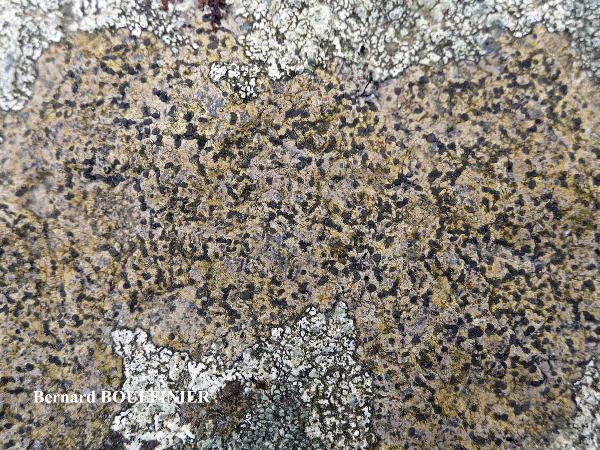
Bernard Bouffinier - Source: http://www.lichensmaritimes.org/index.php?task=fiche&lichen=1157&lang=en
France, Abbaye du Relecq
f. sylvaticum Fryday
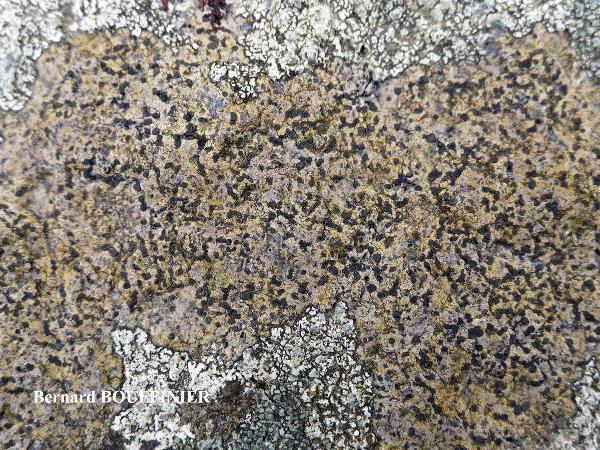
Bernard Bouffinier - Source: http://www.lichensmaritimes.org/index.php?task=fiche&lichen=1157&lang=en
France, Abbaye du Relecq
f. sylvaticum Fryday
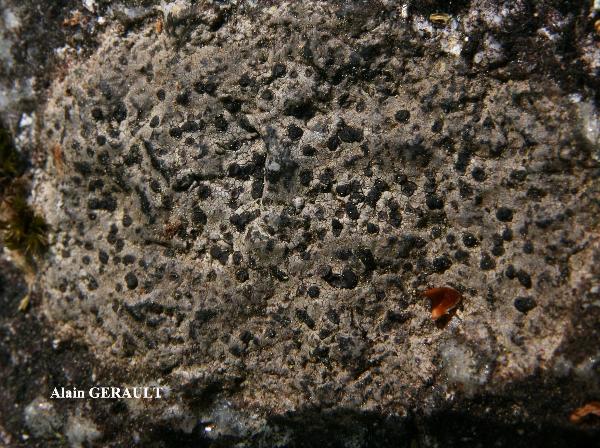
Alain Gerault - Source: http://www.lichensmaritimes.org/index.php?task=fiche&lichen=1157&lang=en
France, Saint Herbot
f. sylvaticum Fryday
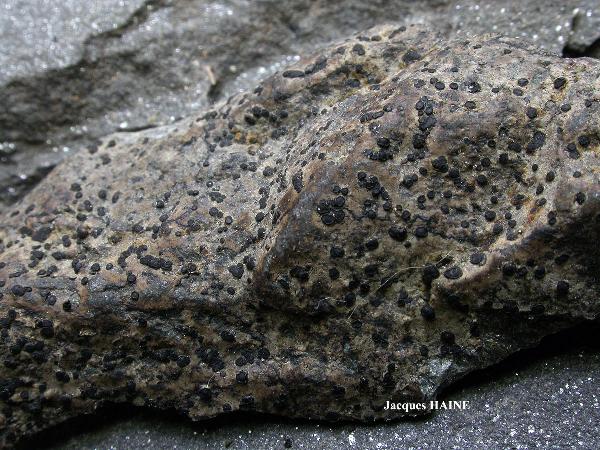
Jacques Haine - Source: http://www.lichensmaritimes.org/index.php?task=fiche&lichen=1157&lang=en
Belgium, Monthermé
f. sylvaticum Fryday
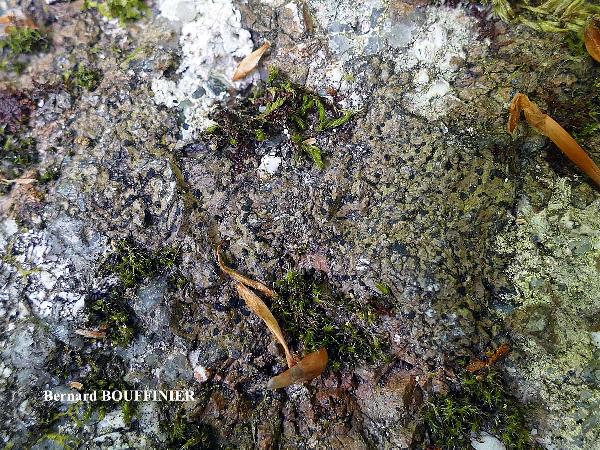
Bernard Bouffinier - Source: http://www.lichensmaritimes.org/index.php?task=fiche&lichen=1157&lang=en
France, Locmaria Berrien
f. sylvaticum Fryday
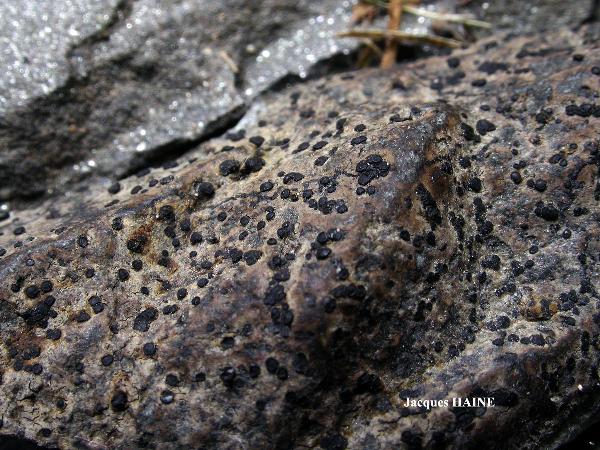
Jacques Haine - Source: http://www.lichensmaritimes.org/index.php?task=fiche&lichen=1157&lang=en
Belgium, Monthermé
f. sylvaticum Fryday
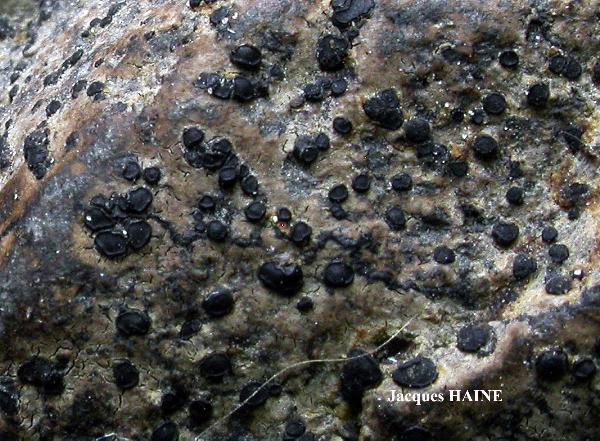
Jacques Haine - Source: http://www.lichensmaritimes.org/index.php?task=fiche&lichen=1157&lang=en
Belgium, Monthermé
f. sylvaticum Fryday
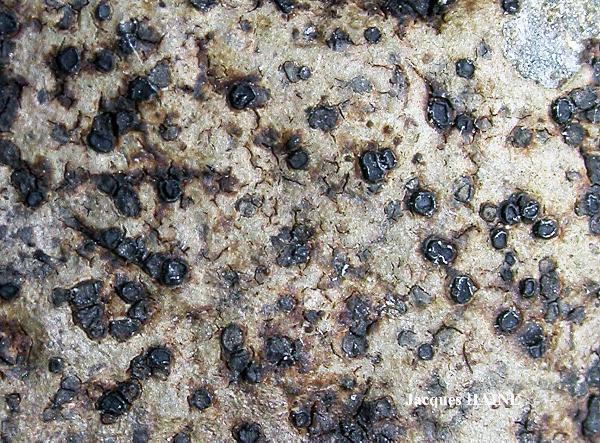
Jacques Haine - Source: http://www.lichensmaritimes.org/index.php?task=fiche&lichen=1157&lang=en
Belgium, Monthermé
f. sylvaticum Fryday
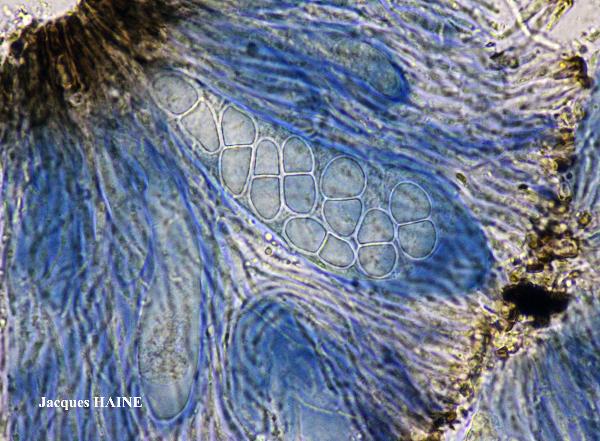
Jacques Haine - Source: http://www.lichensmaritimes.org/index.php?task=fiche&lichen=1157&lang=en
Belgium, Monthermé
f. sylvaticum Fryday
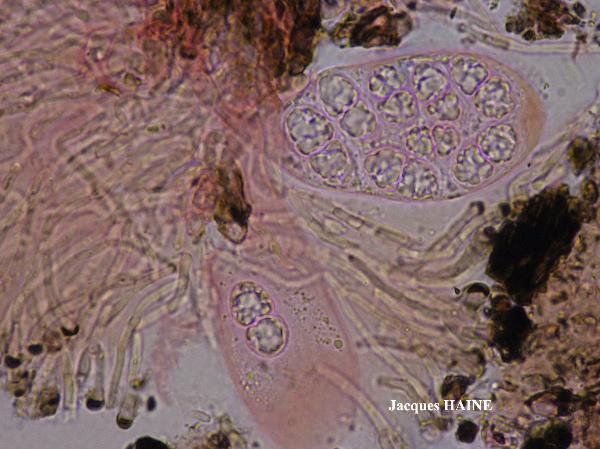
Jacques Haine - Source: http://www.lichensmaritimes.org/index.php?task=fiche&lichen=1157&lang=en
Belgium, Monthermé
f. sylvaticum Fryday
Growth form: Crustose
Substrata: rocks
Photobiont: green algae other than Trentepohlia
Reproductive strategy: mainly sexual
Most common in areas with a humid-warm climate (e.g. most of Tyrrenian Italy)

Predictive model

Jacques Haine - Source: http://www.lichensmaritimes.org/index.php?task=fiche&lichen=1157&lang=en
Belgium, Monthermé
f. sylvaticum Fryday

Bernard Bouffinier - Source: http://www.lichensmaritimes.org/index.php?task=fiche&lichen=1157&lang=en
France, Pont Releq
f. sylvaticum Fryday

Bernard Bouffinier - Source: http://www.lichensmaritimes.org/index.php?task=fiche&lichen=1157&lang=en
France, Pont Releq
f. sylvaticum Fryday

Bernard Bouffinier - Source: http://www.lichensmaritimes.org/index.php?task=fiche&lichen=1157&lang=en
France, Abbaye du Relecq
f. sylvaticum Fryday

Bernard Bouffinier - Source: http://www.lichensmaritimes.org/index.php?task=fiche&lichen=1157&lang=en
France, Abbaye du Relecq
f. sylvaticum Fryday

Alain Gerault - Source: http://www.lichensmaritimes.org/index.php?task=fiche&lichen=1157&lang=en
France, Saint Herbot
f. sylvaticum Fryday

Jacques Haine - Source: http://www.lichensmaritimes.org/index.php?task=fiche&lichen=1157&lang=en
Belgium, Monthermé
f. sylvaticum Fryday

Bernard Bouffinier - Source: http://www.lichensmaritimes.org/index.php?task=fiche&lichen=1157&lang=en
France, Locmaria Berrien
f. sylvaticum Fryday

Jacques Haine - Source: http://www.lichensmaritimes.org/index.php?task=fiche&lichen=1157&lang=en
Belgium, Monthermé
f. sylvaticum Fryday

Jacques Haine - Source: http://www.lichensmaritimes.org/index.php?task=fiche&lichen=1157&lang=en
Belgium, Monthermé
f. sylvaticum Fryday

Jacques Haine - Source: http://www.lichensmaritimes.org/index.php?task=fiche&lichen=1157&lang=en
Belgium, Monthermé
f. sylvaticum Fryday

Jacques Haine - Source: http://www.lichensmaritimes.org/index.php?task=fiche&lichen=1157&lang=en
Belgium, Monthermé
f. sylvaticum Fryday

